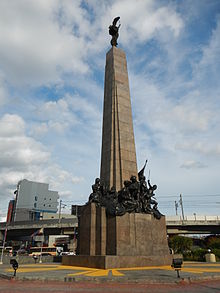Bonifacio Monument
| Monumento ni Bonifacio | |
 |
|
| Coordinates | 14°39′25″N 120°59′02″E / 14.65708°N 120.98397°ECoordinates: 14°39′25″N 120°59′02″E / 14.65708°N 120.98397°E |
|---|---|
| Location | Grace Park, Caloocan |
| Designer | Guillermo Tolentino |
| Height | 45 feet (14 m) |
| Beginning date | November 30, 1929 |
| Opening date | November 30, 1933 |
| Dedicated to | The memory of Andrés Bonifacio, Supremo of the Katipunan |
The Andrés Bonifacio Monument, commonly known simply as Bonifacio Monument or Monumento, is a memorial monument in Caloocan, Philippines which was designed by the National Artist Guillermo Tolentino to commemorate Philippine revolutionary Andrés Bonifacio, the founder and Supremo of the Katipunan. Andrés Bonifacio fought for independence from the politically and socially ruthless colonial rule by Spain. The monument 45 feet (14 m) in height with symbolic images and other features known as the "Cry of Pugadlawin" is acclaimed as one of the best monuments in the world.
The monument is located in South Caloocan at a roundabout crossing of four roads, namely Epifanio de los Santos Avenue (EDSA), MacArthur Highway, Samson Road and Avenida Rizal, the old road leading to Manila.
The Bonifacio Monument recalls the Philippine Revolution which was spearheaded by Andrés Bonifacio who had urged his men to raise against the colonial rule of Spain. His call to take arms against the Spanish rule was given on 23 August 1896, which is widely known as "Cry of Pugad Lawin." The foundation stone for the monument was formally laid by Aurora Quezon, the wife of Filipino Senate President Manuel L. Quezon. The monument, which was created under the orders of Frank Murphy, the Governor-General, was inaugurated on 23 October 1933. It was inaugurated by the Speaker of the House, with much fanfare in a colourful function led by three women from Luzon (of the Women’s College), Visayas (of the Institute of Women), and Mindanao (of the Centro Escolar de Señoritas/Center for Women) with nine women attendants representing the eight provinces of Manila, Cavite, Batangas, Bulacan, Pampanga, Tarlac, Nueva Ecija, and Laguna which had participated in the revolution of 1896.
...
Wikipedia
